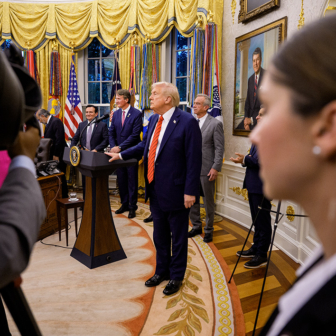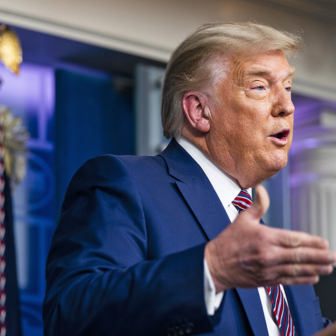When you research vaccination policy for a living, it’s no surprise when the topic pops up outside work hours. And so it does when I catch up with friends in Sydney who have recently become parents. But rather than the usual abstract concerns — “Everyone should vaccinate to protect the community” or “Science denialism is a big problem” — my friends Will and Sophie express a genuine worry that their baby Jack might catch measles.
It’s a reminder that the behaviour, trends and policies that constitute my research life are playing out across the developed world in outbreaks of infectious — and preventable — disease. For Will and Sophie, the current measles outbreak in New South Wales feels very close to home, especially since an alert was placed on the bus route through their inner-city suburb. It seems like a very long time until baby Jack can be vaccinated against a disease that hospitalises more than a quarter of the children who catch it, and can be fatal. “It’s crazy that we are having to worry about measles in this day and age,” says Will. “All because some people don’t want to vaccinate their children.”
Will and Sophie don’t face this anxiety alone. Europeans recently learned that the number of measles infections across the continent last year was the highest in a decade, with 82,596 cases reported by the World Health Organization. Seventy-two resulted in death. And that followed a year of bumper coverage, with record rates of take-up for the first and second doses of the vaccine in 2017. Coverage gaps in older populations still enabled the disease to spread.
In the United States, New York City mayor Bill de Blasio declared a public health emergency on 2 April in response to a months-long measles outbreak in ultra-Orthodox Jewish communities in Brooklyn. City officials are resorting to public health measures Americans have rarely seen in living memory. Measles vaccination has been made mandatory in public spaces, and non-compliers risk fines of US$1000, with the threat of compulsory vaccination written into the order. Still, the city stopped short of announcing random checks to confirm children’s vaccination status; instead, officials hope that the declaration itself will encourage people to take the threat of the disease seriously and make use of the highly effective vaccine.
As Will’s comment shows, the popular view is that the problem comes down to ill-informed parents who trust Google over scientific advice. And it’s true that vaccine refusal has played a role in the outbreaks of measles we have seen in recent years in America, Australia and Europe. Unvaccinated individuals have indeed been at the centre of some outbreaks, notably in Disneyland in 2015, when 147 people were infected, most of whom were not vaccinated or whose vaccination histories were unknown.
The internet’s role was even clearer a few years earlier, after an Italian court ruled that a measles, mumps and rubella, or MMR, shot had caused a child’s autism. Italian-language internet searches about the link between MMR and autism — a link consistently refuted by scientific evidence — increased massively. It made little difference that a higher court eventually overturned the decision; MMR coverage rates slumped to 87 per cent in 2015 for one dose in two-year-olds. (While this might seem a high number, 95 per cent coverage is required to protect those who are too young or unable to be vaccinated, or who are immunocompromised.)
But the picture is more complex than that. Globally mobile populations, insufficient booster coverage in adults, and access barriers among disadvantaged groups also contribute to outbreaks. Measles is a heat-seeking missile that finds and infects those without adequate immunity. It doesn’t differentiate between asylum seekers in Europe, Orthodox Jews in Brooklyn, and newborn babies in Sydney. Nor does it care whether somebody is unvaccinated because they can’t get access or because they won’t. But that distinction matters when governments are choosing from a range of potential responses to threats of outbreaks, or trying to maintain high coverage rates. The two groups — the can’ts and the won’ts — couldn’t be more different.
Disadvantaged groups across the developed world are under-vaccinated because government programs aren’t fully reaching them. They include vulnerable communities of refugees and asylum seekers, and low-income families with chaotic lives or other access problems. Adult and young adult populations may also be susceptible for a range of reasons relating to the history of vaccination technology and scheduling in their countries, and may face particular risks when travelling without booster vaccinations to countries where measles is endemic or resurging. They are also at risk when someone else brings measles home.
Free vaccines, available at convenient places and times, with recalls, reminders and follow-ups, can provide these families with protection they are happy to receive. Financial incentives or entry requirements for schools and childcare centres can also motivate families. One thing is clear: health systems must constantly strive to reach individuals whose already complex lives would be significantly worsened by preventable disease.
But what about those families who refuse the vaccines on offer? Are they simply part of a global, Western, high-income phenomenon? Partially. The drivers of vaccine refusal are multidimensional. Some accounts are familiar the world over; others are unique to certain political communities. National characteristics and stories play a role, as do global flows of (mis)information and ideology. International influences intersect with local and national experiences. All inform the vaccine decisions we make, and constrain what governments can do about them.
In high-income areas, one ubiquitous variant of the vaccine refuser is the natural-minded, low-intervention parent. Having pursued a health-oriented pregnancy and a natural birth, and with plans to breastfeed, buy only organic food and resist “junk” culture, some new parents perceive vaccines as unnatural and unnecessary. Social processes may enable such views to dominate particular communities, stymieing vaccine supporters’ confidence to speak up. As vaccine refusal self-perpetuates, the clustering of like-minded families makes their communities more vulnerable to outbreak.
Supporting this trend are celebrities like the Australian chef “Paleo” Pete Evans, who uses his platform as judge of a high-rating TV cooking contest to proselytise against vaccines. Parents’ peers also reinforce the notion that lifestyle vaccine refusers are critical thinkers who like to make up their own minds about what is best for their children’s health. Government responses need to be wary of “cuing” other natural-lifestylers into vaccine rejection by pointing out what “people like them” are doing.
If the natural-minded vaccine refuser is a cross-national variant, local experiences and stories are also grinding away at public confidence, both within specific pockets and nationally. Long before the measles outbreaks in Orthodox Jewish communities in New York, British scholars were examining why Orthodox Jews in London were rejecting vaccines. (The mothers interviewed saw their tight-knit communities as insulated against some diseases and, like other British parents at the time, were influenced by the media to collectively worry about the MMR vaccine.) In France and Italy, controversy over influenza vaccination harmed public confidence. Populations can be unforgiving when it comes to vaccinations, and trust is hard to rebuild.
Governments engaging with vaccine refusal have a number of tools at their disposal, with vaccine mandates the hardest-hitting. The choice will be determined by the epidemiological context, the history and current mix of levers in place, and the political culture of the nation. Beyond funding the high-functioning programs already mentioned, governments should invest heavily in well-researched and targeted communication and social marketing campaigns to normalise vaccination as a health-promoting practice. These can be pitched to subgroups by opinion leaders and peers whom parents trust and identify with, and could involve representing vaccination as part of a natural, healthy and ethical lifestyle.
Language and representation is important. Not all parents who worry about vaccines are “anti-vaxxers,” and public discourse should avoid depicting them as such. Governments need to work hard to reach parents and reassure them that vaccines are safe, effective and necessary. Public commentators would be wise to remember that hectoring worried parents can push them into the arms of the sceptics. In US states such as Michigan and Washington, as well as in Germany, mandatory schemes linking vaccination to access to public institutions or providing financial incentives have also proved relatively uncontroversial when they enable “informed declination” following medical counselling or compulsory education classes. In Australia, they have already been superseded.
Where there is wiggle room for refusers, there will be those who call for tougher measures. Australia, Italy, France and California have all recently tightened the screws, revamping existing vaccination policies to impose consequences on refusing families. Officials report higher coverage as a result, but the fact that these policies are often accompanied by additional investments in vaccine promotion and services means the truth is more complex. Germany and Washington State are talking of similar action, despite only recently revamping their own policies to make opting out of vaccination more difficult.
The consequences that governments impose under such regimes vary vastly, as do the implementation and enforcement. Strict vaccine mandates raise questions about proportionality, effectiveness and moral justification, especially in settings where vaccine refusers are few. Such questions are epidemiological but also political: they prompt consideration of what policymakers actually intend to achieve.
Australians’ widespread, bipartisan support for recent vaccination policy changes indicates comfort with governments telling them what to do. Australians seem to accept the idea that access to public goods might come at the price of limits on their individual freedom. In Italy, by contrast, stricter mandates might have received popular support in opinion polls but voters ultimately ousted the government that brought them in. Many threw their support behind the populist Five Star Movement, which had previously aligned with critics of both vaccines and mandates but is now recognising a public health crisis staring it in the face and dialling up support for vaccination. Globally, political polarisation and populism are drawing in supporters and opponents of both vaccination and mandatory vaccination — which overlap in some political communities more than others. Researchers look with concern to fields like climate change and hope that vaccination does not become similarly embroiled.
Amid this storm, Will and Sophie can take some comfort from the highly effective vaccination programs operating around young Jack. Childhood vaccination coverage rates in Australia have never been higher. But just as the recent measles outbreaks globally have posed threats even in communities with high coverage, their experience in inner Sydney demonstrates that vaccination policies will continue to be political as well as epidemiological. Perceptions that others are placing our loved ones at risk drive policies addressing public concern as much as — or more than — public health findings. •




